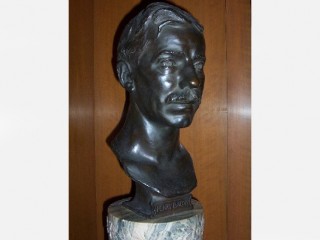
Henry Bacon biography
Date of birth : 1866-11-26
Date of death : 1924-02-14
Birthplace : Watseka, Illinois
Nationality : American
Category : Arhitecture and Engineering
Last modified : 2010-06-10
Credited as : Architect, Union Square Savings Bank,
0 votes so far
Brother was the architect and interior designer Francis Henry Bacon (1856-1940). Studied at University of Illinois, Champaign-Urbana, 1884. Worked as draftsman, Chamberlin and Whidden, Boston, 1885, then joined McKim, Mead and White, New York; won Rotch Traveling Scholarship and traveled to Europe, 1889-91; worked again for McKim, Mead and White, 1891-97; partnership with James Brite (died in 1942) as Brite and Bacon, 1897; opened own office, 1902. Gold Medal, American Institute of Architects, 1923.
Leader in the Beaux-Arts Style.
Henry Bacon's greatest accomplishment was designing the Lincoln Memorial in Washington, D.C. (completed in 1917 and dedicated in 1922), a project that reflects his profound commitment to American democratic ideals. In his time Bacon was respected as one of the most talented exponents of the fashionable Beaux-Arts style of architecture, so-called because it was taught at the Ecole des Beaux-Arts in Paris. Based on a careful study of antiquity and often combining an eclectic use of other historic elements, this style placed great emphasis on refinement of taste and made up in elegance and sophistication what it sometimes lacked in vitality and originality. Bacon's contribution to the American interpretation of Beaux-Arts design was a pure classicism born of his great love for ancient Greek and Roman art and architecture. Yet perhaps his most significant legacy to American architecture was his collaboration with some of the foremost sculptors of his day, including Daniel Chester French (who sculpted the statue of Abraham Lincoln for the Lincoln Memorial) and Augustus Saint-Gaudens.
Training and Apprenticeship.
Henry Bacon was born on 28 November 1866 in Watseka, Illinois, a village near Chicago. He studied engineering and architecture at the University of Illinois in 1884-1885, leaving to work for Chamberlin and Whidden, an architectural firm in Boston, where he was first exposed to the Beaux-Arts style. Three years later he moved to the celebrated firm of McKim, Mead and White in New York City. His work at Chamberlin and Whidden qualified him to enter the prestigious Rotch traveling-scholarship competition, which he won in 1889 with his design for an "Art College in a City Park." This scholarship permitted Bacon to spend two years in Europe, where he immersed himself in a study of classical architecture. Returning to McKim, Mead and White in 1891, he remained with the firm until 1897, when he became cofounder of Brite and Bacon. Five years later he formed his own independent firm.
Monuments and Memorials.
Although his schools, hospitals, libraries, railroad stations, and banks were also admired, Bacon's memorials and monuments seemed to embody best the classical ideals he brought to his work. Among them are the base of the memorial to Gen. William Tecumseh Sherman in New York and the memorial to Charles Parnell in Dublin, Ireland, one of several on which he collaborated with Saint-Gaudens. Bacon believed that these memorials ought to inspire reverence and mystery in the viewer and often set his monuments in secluded areas, "for then, in quiet, and without distraction of the senses or mind, the beholder is alone with the lesson which the object is designed to teach and inspire." He began preliminary work on the Lincoln Memorial in 1911, chosen because of his extensive training in Beaux-Arts architecture during his association with McKim, Mead and White. With its row of fluted Doric columns, the memorial was inspired by the Parthenon, which Bacon had visited on his European travels. The Lincoln Memorial has become one of the best-loved monuments in America, a symbol of liberty for succeeding generations.
Awards.
In 1923 Bacon won the Gold Medal of the American Institute of Architects for his Lincoln Memorial design. He was also a member of the National Academy of Arts and Sciences, as well as the American Academy of Arts and Letters. He died on 16 February 1924.
He designed, among others, the following buildings:
Public Library, Paterson, N. J.; Memorial Day Nursery, Paterson, N. J.; Halle Brothers Department Store, Cleveland, Ohio; Railroad Station, Naugatuck, Conn.; Waterbury General Hospital, Waterbury, Conn.; Memorial Bridge, Naugatuck, Conn.; Union Square Savings Bank, New York City; Chelsea Savings Bank, Chelsea, Mass.; National City Bank, New Rochelle, N. Y.; Citizens & Manufacturers National Bank, Waterbury, Conn.; Court of the Four Seasons, Panama-Pacific Exposition, San Francisco; Electrical Society Building, Middletown, Conn.; Astronomical Observatory, a dormitory, and the general plan of the University in connection with its future extension, Middletown, Conn.; gates for the University of Virginia, Charlottesville, Va.; First Congregational Church (alterations), Providence, R. I.; Woodmere High School, Woodmere, N. Y.; Public Bath, Brooklyn, N. Y. In collaboration with Daniel Chester French there were designed some fifty memorials and monuments, of which the principal ones are: Parkman Monument, Jamaica Plain, Mass.; Melvin Monument, Concord, Mass.; Oglethorpe Monument, Savannah, Ga.; Marshall Field Monument, Chicago, Ill.; Spencer Monument, Atlanta, Ga.; Lincoln Monument, Lincoln, Nebr.; Draper Monument, Milford, Mass.; Longfellow Monument, Cambridge, Mass.; Spencer Trask Memorial, Saratoga Springs, N. Y.; Lafayette Monument, Brooklyn, N. Y.; Republic Monument, Chicago, Ill.; Du Pont Fountain, Washington, D. C.; War Memorial for the State of Massachusetts, St. Mihiel, France. With Saint-Gaudens there were designed the Parnell Monument, Dublin, Ireland; Hanna Monument, Cleveland, Ohio; Whistler Monument, West Point, N. Y.; Magee Memorial, Pittsburgh, Pa.; Gov. Flower Memorial, Watertown, N. Y.
















